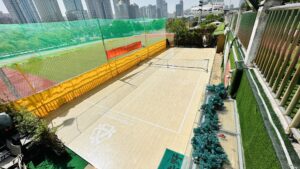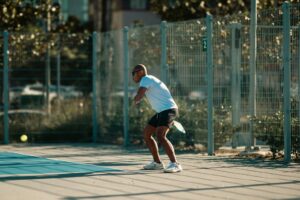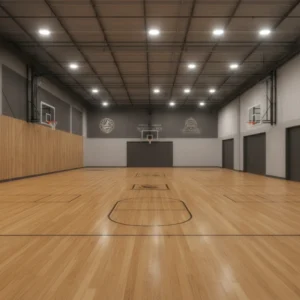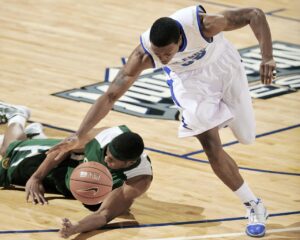Holding a pickleball paddle may seem like a simple task, but mastering the proper grip and technique can greatly impact your game, whether you’re a beginner or an experienced player.
Having a solid understanding of how to hold your pickleball paddle is essential for control, power, and accuracy on the pickleball court. In this blog post, we will guide you through the different grips and provide step-by-step instructions on how to hold your pickleball paddle like a pro.
So, let’s get started and discuss all the factors of how to hold pickleball paddle.
Grip Techniques for Holding a Pickleball Paddle
Whether you’re a beginner or a seasoned player, one of the fundamental skills you need to master is how to hold your pickleball paddle. The way you grip your paddle can greatly affect your control, power, and overall performance on the court.
The purpose of this section is to provide you with an overview of the different pickleball grip styles and techniques so that you can find the one that works best for you.
Pickleball Grip Pressure: Finding the Perfect Balance
One variable to consider when it comes to pickleball grips is grip pressure. As you progress in your pickleball skills, you will discover that altering your grip pressure depending on the type of shot can greatly impact your execution.
For instance, when hitting serves and powerful drives, holding the paddle with a firmer grip can help engage more of your arm and overall strength, resulting in a more powerful shot. When choosing a pickleball paddle, consider these aspects according to your needs and playing style.
On the other hand, when playing at the net and hitting softer dink shots or blocking drives from your opponent, holding the paddle with a softer grip can help deflect your opponent’s power and pace, allowing you to respond with a softer shot.
The Continental Grip: A Great Choice for Beginners
The Continental grip is a popular choice among beginners when it comes to holding a paddle. It is a great option for those who are just starting in the sport. This grip provides you with excellent control near the net, which is perfect for playing close to the net.
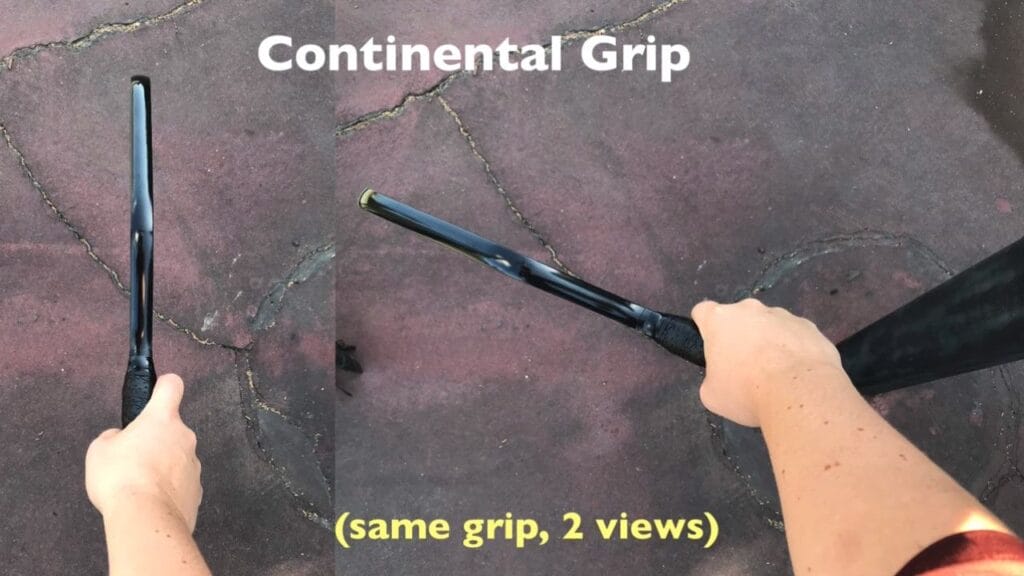
However, it may be slightly more challenging to hit passes and drives from the baseline. So, if you are new to the game, the Continental grip can be a friendly choice to help you get started on the right foot.
Pros:
- Power and Control: One of the main advantages of the Continental grip is the ability to generate maximum power on backhand shots. This grip allows players to strike the ball with a forward motion, resulting in more power and control.
- Consistency: The Continental grip also aids in producing more accurate dinks and returns without the need to change your grip between shots. This helps players maintain consistency in their shots, especially for beginners who are still honing their skills.
- Versatility: The Continental grip is a versatile grip that can be used for various shots. It allows players to easily switch between forehand and backhand shots without having to adjust their grip, making it a convenient choice for players of all levels.
Cons:
- Forehand Power: While the Continental grip excels in generating power on backhand shots, it may have slightly less power on forehand shots compared to other grip choices. Players who rely heavily on their forehand may find this grip slightly limiting in terms of power.
Eastern Pickleball Grip: Adding Power to Your Shots
The Eastern grip, often described as “shaking hands” with the paddle, allows you to add power to both your forehand and backhand shots. To achieve this grip, rotate your hand slightly clockwise as a right-handed player or counterclockwise as a left-handed player. This shift in positioning allows you to hold the third bevel instead of the second bevel of the handle, providing leverage and positioning to impart power and spin on the ball.

Pros:
- Natural Hand Position: The Eastern grip offers a very natural hand position, making it comfortable and easy to adopt for beginners. This natural feel helps players to quickly develop their skills and get a good grasp of the game.
- Flexibility: With the Eastern grip, players have the flexibility to execute various shots without having to switch grips. This versatility is particularly advantageous for beginners who are still learning the different strokes and techniques of pickleball.
Cons:
- Limited Topspin: One of the drawbacks of the Eastern grip is its limited ability to produce effective topspin. More advanced players may find it challenging to generate the desired amount of topspin, which can affect the trajectory and control of their shots.
- Power Limitations: Some players feel that the Eastern grip doesn’t provide the power they seek, especially when compared to other grip types. This can be a disadvantage for those who rely on power shots to gain an edge in the game.
The Western Grip: Taking It Up a Notch
Once you have mastered the Eastern grip, transitioning to the Western grip is relatively easy. Just give your hand a little twist to the right or clockwise. With the Western grip, your index knuckle will rest on the third bevel to the right of the flat top bevel.
This grip is commonly referred to as the “frying pan grip” because it resembles how you might hold a pan when flipping pancakes. The closed paddle face allows you to see the back of the paddle when held straight out in front of you.
Pros:
- Maximum Power: The Western grip positions the hand behind the paddle on forehand shots, allowing players to generate incredible power. This makes it ideal for hitting super-powerful shots while still keeping the ball in the court.
- Top Spin: The closed face of the paddle in the Western grip enables players to produce effective topspin. This can be advantageous in creating shots that dip quickly over the net and stay low, making it harder for opponents to return.
Cons:
- Backhand Difficulty: One drawback of the Western grip is its effect on the backhand. With the hand positioned off-center and to the side of the handle, the face of the paddle angles upwards or open. This can cause the ball to pop up unless the player adjusts their wrist position. Some players even resort to using a forehand shot with the paddle turned clockwise rather than attempting a traditional backhand.
- Limited Shot Options: Hitting shots from a low position or generating a slice/backspin on the forehand side becomes challenging with the Western grip. This restricts the variety of shots that can be executed effectively.
- Skill Level Requirement: Due to its technical demands, the Western grip is recommended for intermediate to advanced players. It is not suitable for beginners unless they have prior experience with a similar grip in another racket sport.
Finger Placement: Pickleball Grip Index Finger
Regardless of your preferred grip style, you have the option to extend your index finger up onto the paddle or leave it wrapped around the handle with the rest of your hand. This is a matter of personal preference and can be experimented with to find what feels most comfortable and best suits your playing style.
Finger Down: Adding Leverage and Power
Situating your hand lower on the handle and wrapping your index finger around the grip, also known as the finger-down grip, allows for more wrist manipulation.
This added wrist movement helps generate more leverage for your drives, enabling you to put more power and spin on your shots. The finger-down grip is an excellent choice for players who rely on powerful shots.
Finger Up: Precision and Control
Placing your index finger on the edge of the paddle or even on the lower part of the hitting surface, also known as the finger up grip, locks your wrist in place, similar to a golf grip.
This creates a cohesive lever from your elbow down, enhancing your precision with drop shots, resets, and dinks. However, the finger-up grip may provide slightly less leverage for drives.
It’s important to note that occasionally, when hitting backhand shots, the ball might bounce off the finger, potentially causing a miss-hit or discomfort, although this is a rare occurrence. Remember, finding the right grip is a personal journey, and what works for one player may not work for another.
Take the time to experiment with different grip techniques and find the one that feels most natural and comfortable to you. Also, don’t be afraid to seek advice from experienced players or even invest in a professional coach who can help you fine-tune your grip for optimal performance.
Tips for Improving Your Grip Strength and Control
Incorporate Specific Grip Exercises
One of the best ways to improve your grip strength is by incorporating specific grip exercises into your workout routine. Exercises such as deadlifts, farmer’s walks, and pull-ups can do wonders for strengthening your grip. Make sure to focus on maintaining a tight grip throughout these exercises to maximize the benefits.
Utilize Grip Strengthening Tools
In addition to specific exercises, there are various grip-strengthening tools available that can help you in your journey. Grip trainers, hand grippers, and grip balls are just a few examples. These tools provide targeted resistance, allowing you to work on your grip strength and control in a controlled and progressive manner.
Don’t Neglect Forearm Training
Your forearm muscles play a crucial role in grip strength, so it’s important not to neglect them. Incorporate forearm exercises such as wrist curls, reverse curls, and forearm planks into your routine. Strengthening your forearms will provide a solid foundation for improving your grip strength and control.
Practice Static Holds
Static holds are an excellent way to improve your grip strength and control. Hold onto a barbell, dumbbell, or any other heavy object for as long as you can. Start with shorter holds and gradually increase the duration as your grip strength improves. This exercise will challenge your grip and help you develop endurance.
Focus on Proper Form
Maintaining proper form during exercises is crucial for maximizing grip strength and control. Pay attention to your hand placement, grip width, and overall posture. By focusing on proper form, you’ll engage the correct muscles and reduce the risk of injury.
Allow Time for Rest and Recovery
Just like any other muscle group, your grip muscles need time to rest and recover. Overtraining can lead to fatigue and hinder your progress. Listen to your body when it comes to rest days, and keep your training schedule balanced. Adequate rest will allow your grip strength to improve steadily.
By incorporating these friendly tips into your routine, you’ll be well on your way to achieving a stronger grip that will benefit you in various aspects of your life. Remember to be patient, stay consistent, and enjoy the journey.
Conclusion.
Holding a pickleball paddle is an essential skill that can greatly improve your game. By following these simple steps, you’ll be able to find a grip that feels comfortable and allows for optimal control and power.
Remember to relax your grip, maintain a loose wrist, and experiment with different grips to find what works best for you. With practice and patience, you’ll soon be confidently holding your pickleball paddle like a pro.
FAQs
How to Pick a Pickleball Paddle?
When choosing a pickleball paddle, consider your playing style and level of experience. Look for a paddle that offers a good balance of power and control. Consider the weight, grip size, and materials used.
It’s also helpful to try out different paddles, if possible, to find one that feels comfortable in your hand. Remember, the right paddle can enhance your game and make it even more enjoyable.
How Do I Choose a Pickleball Grip?
To choose a pickleball grip, consider factors like comfort and grip texture. Look for a grip that feels comfortable in your hand and provides a secure hold on the paddle. Some players prefer a cushioned grip for added comfort, while others prefer a tackier grip for better control. Ultimately, it’s a personal preference, so try out different grips to find the one that suits you best.
What is a Grip in Pickleball?
A grip in pickleball refers to how you hold the paddle. It’s important to find a grip that feels comfortable and allows for control and power in your shots. There are different types of grips, such as the continental grip and the eastern grip, that players can use based on their preference and playing style.


